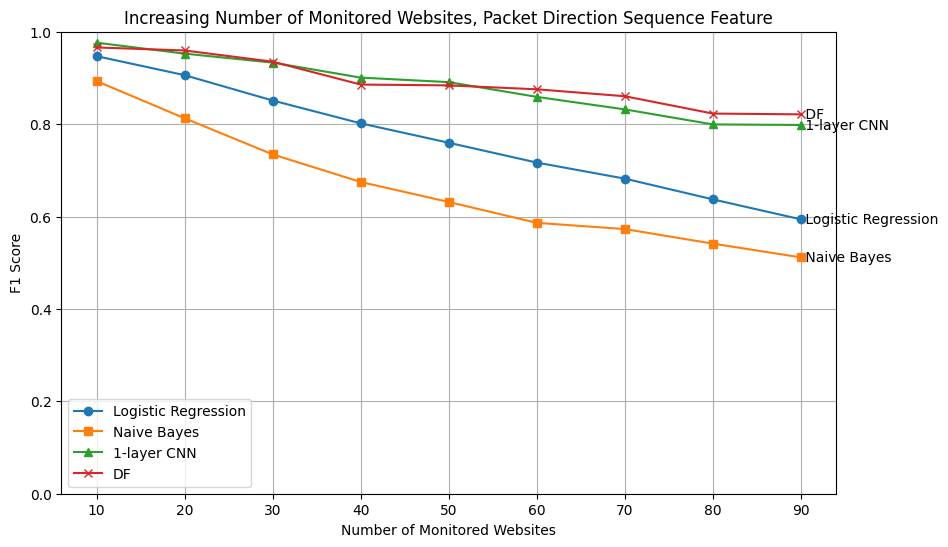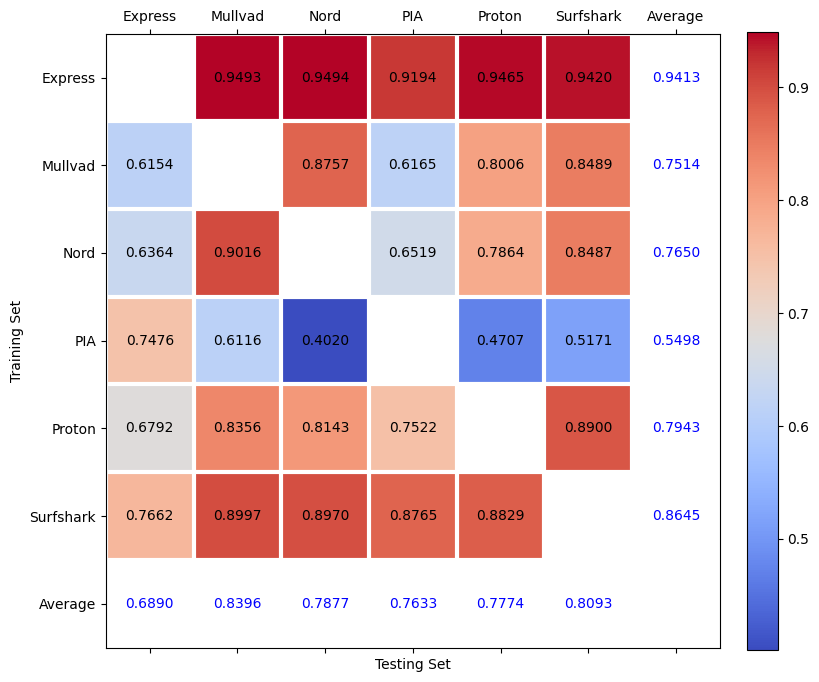Author
Steven Oufan Hai
Mentors
Adam Purtee and John Criswell
Abstract
VPNs are increasingly promoted as a privacy-enhancing technology and a solution to protecting users’ privacy from surveillance and cyber attacks. While most VPN protocols encrypt users’ browsing traffic, the research community has repeatedly demonstrated that encryption algorithms need not be broken for malicious agents with knowledge of users’ encrypted traffic to fingerprint the websites they visit. We investigate whether advancements in VPN technologies in the last two decades make VPNs harder to fingerprint. We collected 643 GB of raw Internet Traffic containing about 400,000 traces. We train and evaluate supervised machine learning models on the VPN traffic collected through open-world website fingerprinting. Our simple but effective machine learning classifiers achieved performance (F1 ≈ 0.95) comparable to those classifiers using deep neural networks for commercial VPNs. We show that VPN traffic is at least as easy to fingerprint as bare HTTPS traffic. We also found generalizability in models trained on certain VPN datasets. Our findings suggest that modern commercial VPNs urgently need to implement features that deter website fingerprinting.
Background
VPNs are increasingly promoted as a privacy-enhancing technology and a solution to protecting users’ privacy from surveillance and cyber attacks. While most VPN protocols encrypt users’ browsing traffic, the research community has repeatedly demonstrated that encryption algorithms need not be broken for malicious agents with knowledge of users’ encrypted traffic to fingerprint the websites they visit. We investigate whether newer VPN technologies (protocols and privacy-enhancing features) make VPN traffic harder to fingerprint.
Contributions
- New datasets containing 643 GB of VPN traffic.
- We show that when performing website fingerprinting on VPN traffic, simple but effective machine learning classifiers achieved performance (F1 ≈ 0.95) comparable to classifiers using deep neural networks.
- We show that VPN traffic is often as easy to fingerprint as bare HTTPS traffic.
- Website Fingerprinting classifiers trained on one dataset remain effective when evaluated on different datasets.
Threat Model
We assume the attacker has direct access to users’ Internet traffic. Some entities with such capabilities are the state (especially authoritarian ones), Internet Service Providers (ISPs), and compromised machines on the same network.
We assume the attacker is able to purchase all the commercial VPNs available on the market. The attacker collects their own datasets to train custom machine learning models. Similar to Sirinam et al.’s threat model, we further assume that the attacker has a list of “monitored” websites. The goal of website fingerprinting attacks is to determine if the user visits a website in the monitored set [2].
Data Set Creation
- Packet Capturing: Capturing `.pcap’ files using Selenium and tcpdump.
- Feature Extraction: We extract three types of features [1,3] from the network traffic captured.
- Length + Direction (e.g. [4, -54, 60, -60, 54])
- Direction (e.g. [1, -1, 1, -1, 1])
- Unique Packet Sizes (e.g. [4, 54, 60])
Experiments
Performance of Models
Deep CNN-based website fingerprinting models (e.g., Deep Fingerprinting with 8 Convolutional Layers [2]) do not perform significantly better than simple models (e.g., single-layered CNN) when the number of monitored websites is less than 100.
 Performance of Features
Performance of Features
VPN traffic is at least as easy to fingerprint as bare HTTPS traffic when the right feature is used. 1-dimensional metadata (packet direction sequence) makes VPN traffic more fingerprintable than HTTPS.
| Length + Direction | Direction | Unique Sizes | |
|---|---|---|---|
| HTTPS | 0.8995 | 0.7211 | 0.7470 |
| OpenVPN | 0.8854 | 0.9156 | 0.7439 |
| WireGuard | 0.8954 | 0.9500 | 0.7437 |
| Average | 0.8935 | 0.8622 | 0.7448 |
Cross-VPN Fingerprinting
We found that classifiers trained on one dataset remain effective when evaluated on different datasets. For example, machine learning models trained on ExpressVPN traffic accurately classify the NordVPN traffic.
 Conclusion
Conclusion
Our results challenge commercial VPN providers’ claim that their services could serve as an effective deterrence against surveillance and cyber attacks. With limited data (our largest training set contains 20,000 traces), we trained classifiers that are highly effective at fingerprinting websites. We conclude that website fingerprinting continues to be a challenge to privacy.
Acknowledgments
I give my most sincere thanks to my advisors, Professor Adam Purtee and Professor John Criswell, for their invaluable guidance over the past year. I also thank Prof. Andrew Read-McFarland for his advice.
I am very grateful to the River Campus Library at the University of Rochester for supporting this research project with the Data Set Grant for two consecutive terms. I thank the great librarians I have worked with: Kathy Wu, Arjay Romanowski, and Heather Owen.
Reference
[2] Payap Sirinam, Mohsen Imani, Marc Juarez, and Matthew Wright. Deep fingerprinting: Undermining website fingerprinting defenses with deep learning. In Proceedings of the 2018 ACM SIGSAC Conference on Computer and Communications Security, 2018.
[3] Junhua Yan and Jasleen Kaur. Feature selection for website fingerprinting. Proceedings on Privacy Enhancing Technologies, 2018.
